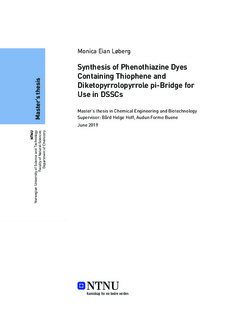| dc.contributor.advisor | Bård Helge Hoff | |
| dc.contributor.advisor | Audun Formo Buene | |
| dc.contributor.author | Monica Eian Løberg | |
| dc.date.accessioned | 2019-10-24T14:00:20Z | |
| dc.date.available | 2019-10-24T14:00:20Z | |
| dc.date.issued | 2019 | |
| dc.identifier.uri | http://hdl.handle.net/11250/2624230 | |
| dc.description.abstract | Fargestoff-solceller er nye og voksende fotovoltaiske teknologier som gjør at solceller kan være halvtransparente, fleksible og av justerbar farge. Disse solcellene har utkonkurrert de fleste andre etablerte fotovoltaiske teknologier under naturlige lysforhold. Noen av bruksområdene til fargestoff-solcellene er bygningsintegrasjon og strøm til gjenstander i tingenes internett.
Vår forskningsgruppe på NTNU har forsket på fenotiazin-baserte fargestoffer. En metode for å senke båndgapsenergien og øke lysinnsamlingen er ved å lage fargestoff med elektronfattige enheter i det konjugerte systemet. Denne masteravhandlingen presenterer syntesen av tre nye fenotiazin fargestoffer som inneholder en (MEL1) eller to (MEL2) tiofener eller diketopyrrolopyrrole (MEL3) som en del av π-broen. Etter en firetrinns syntese ble MEL1 og MEL2 syntetisert med et totalt utbytte på henholdsvis 44% og 20%. Fargestoffet MEL3 ble syntetisert med en femtrinns syntese, og hadde det mest rødskiftede adsorpsjonsspekteret av de tre fargestoffene. | |
| dc.description.abstract | Dye-sensitized solar cells (DSSCs) is an emerging new photovoltaic (PV) technology, allowing solar cells to be semi-transparent, flexible and of tuneable colour. Under ambient light conditions, DSSCs have out-performed most other long established PV technologies. Hot applications of DSSCs include building integration and powering an increasing number of devices in the Internet of Things (IoT).
Our group at NTNU has initially focused on phenothiazine based dyes. A method to lower the band gap and increase light harvest is to incorporate electron deficient units into the conjugated system. This thesis presents chemistry to synthesize three novel phenothiazine dyes containing one (MEL1) or two thiophenes (MEL2) or diketopyrrolopyrrole (MEL3) as part of the π-bridge. After a four-step synthesis, MEL1 and MEL2 were synthesized in a total yield of 44% and 20%, respectively. The novel dye MEL3 was synthesized in a five-step synthesis, and had the most red-shifted adsorption spectra of the three dyes. | |
| dc.language | eng | |
| dc.publisher | NTNU | |
| dc.title | Synthesis of Phenothiazine Dyes Containing Thiophene and Diketopyrrolopyrrole pi-Bridge for Use in DSSCs | |
| dc.type | Master thesis | |
